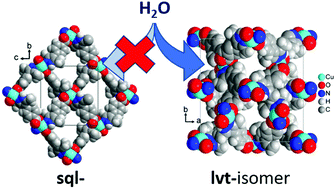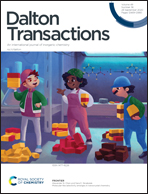Increase of network hydrophilicity from sql to lvt supramolecular isomers of Cu-MOFs with the bifunctional 4-(3,5-dimethyl-1H-pyrazol-4-yl)benzoate linker†
Abstract
The bifunctional linker 4-(3,5-dimethyl-1H-pyrazol-4-yl)benzoic acid (H2mpba) was used for the synthesis of new (square lattice) sql 2D metal–organic frameworks (MOFs) [Cu(Hmpba)2]·L (L = DMF or ACN) in a solvent-mixture of dimethylformamide/water and acetonitrile/water. These sql 2D MOFs are supramolecular isomers of the lvt 3D network [Cu(Hmpba)2]·4MeOH·1H2O (lvt-MeOH) that was synthesized previously by Richardson and co-workers. All these frameworks are potentially porous structures with solvent molecules included in the channels of the as synthesized materials. After activation all three materials showed good CO2 adsorption capacity, demonstrated here for lvt-MeOH for the first time, with a saturation uptake of 113 cm3 g−1 (lvt-MeOH-act.), 111 cm3 g−1 (sql-DMF-act.) and 90 cm3 g−1 (sql-ACN-act.) at 195 K. The flexibility of the lvt-MeOH-act. network is evidenced by a gate-opening effect seen in the CO2 measurement at 195 K and under gravimetric high-pressure CO2 adsorption. According to the water and ethanol sorption measurements the new sql frameworks can be categorized as hydrophobic materials in contrast to the hydrophilic lvt framework. In the lvt-MeOH structure the crystal solvent can be replaced with water to yield the structurally authenticated water-only network lvt-H2O containing 3D arrays of S4-symmetric (H2O)20 clusters.

- This article is part of the themed collection: Celebrating our Golden Authors


 Please wait while we load your content...
Please wait while we load your content...